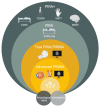Biomarkers of Progression Independent of Relapse Activity-Can We Actually Measure It Yet?
- PMID: 40429847
- PMCID: PMC12112593
- DOI: 10.3390/ijms26104704
Biomarkers of Progression Independent of Relapse Activity-Can We Actually Measure It Yet?
Abstract
Progression independent of relapse activity (PIRA) is increasingly recognized as a key driver of disability in multiple sclerosis (MS). However, the concept of PIRA remains elusive, with uncertainty surrounding its definition, underlying mechanisms, and methods of quantification. This review examines the current landscape of biomarkers used to predict and measure PIRA, focusing on clinical, imaging, and body fluid biomarkers. Clinical disability scores such as the Expanded Disability Status Scale (EDSS) are widely used, but may lack sensitivity in capturing subtle relapse-independent progression. Imaging biomarkers, including MRI-derived metrics (brain and spinal cord volume loss, chronic active lesions) and optical coherence tomography (OCT) parameters (retinal nerve fiber layer and ganglion cell-inner plexiform layer thinning), offer valuable insights, but often reflect both inflammatory and neurodegenerative processes. Body fluid biomarkers, such as neurofilament light chain (NfL) and glial fibrillary acidic protein (GFAP), are promising indicators of axonal damage and glial activation, but their specificity for PIRA remains limited. This review emphasizes the distinction between predicting PIRA-identifying individuals at risk of future progression-and measuring ongoing PIRA-related disability in real time. We highlight the limitations of current biomarkers in differentiating PIRA from relapse-associated activity and call for a clearer conceptual framework to guide future research. Advancing the precision and utility of PIRA biomarkers will require multimodal approaches, longitudinal studies, and standardized protocols to enable their clinical integration and to improve personalized MS management.
Keywords: biomarker; measure; multiple sclerosis; progression independent of relapse activity.
Conflict of interest statement
Gabriel Bsteh has participated in meetings sponsored by and has received speaker honoraria or travel funding from Biogen, Celgene/BMS, Janssen, Lilly, Medwhizz, Merck, Neuraxpharm, Novartis, Roche, Sanofi-Genzyme, and Teva, and has received honoraria for consulting Adivo Associates, Biogen, Celgene/BMS, Janssen, Merck, Novartis, Roche, Sanofi-Genzyme, and Teva. He has received unrestricted research grants from Celgene/BMS and Novartis. He serves on the Executive Committee of the European Committee for Treatment and Research in Multiple Sclerosis (ECTRIMS) and the Board of Directors of the International Multiple Sclerosis Visual System Consortium (IMSVISUAL). Assunta Dal-Bianco: A.D.-B.’s position as junior group leader for Translational Morphology in Neuroscience is supported by a research grant from Biogen. She has participated in meetings sponsored by and has received speaker honoraria or travel funding from Biogen, Celgene (BMS), Merck, Novartis, Roche, and Sanofi, and has received an unrestricted grant from Merck GmbH, an affiliate of Merck KGaA. Nik Krajnc has participated in meetings sponsored by and has received speaker honoraria or travel funding from Alexion, BMS/Celgene, Janssen-Cilag, Merck, Neuraxpharm, Novartis, Roche, and Sanofi-Genzyme, and has held a grant for a Multiple Sclerosis Clinical Training Fellowship Programme from the European Committee for Treatment and Research in Multiple Sclerosis (ECTRIMS). Thomas Berger has participated in meetings sponsored by and has received honoraria (lectures, advisory boards, consultations) from the following pharmaceutical companies marketing treatments for MS: Allergan, Bayer, Biogen, Bionorica, BMS, Eisai, Genesis, GSK, Jazz Pharma, Horizon, Janssen-Cilag, MedDay, Merck, Neuraxpharm, Newbridge, Novartis, Octapharma, Roche, Sandoz, Sanofi, Teva, TG Pharmaceuticals, and UCB. He serves as member of the DSMB (Cellerys AG) and IRAP (TG Therapeutics) clinical trial boards. His institution has received financial support in the past 12 months from unrestricted research grants (Biogen, Bayer, BMS, Merck, Novartis, Roche, Sanofi, and Teva, and for participation in clinical trials in multiple sclerosis sponsored by Alexion, Bayer, Biogen, Merck, Novartis, Octapharma, Roche, Sanofi, and Teva).
Figures

References
-
- Kappos L., Wolinsky J.S., Giovannoni G., Arnold D.L., Wang Q., Bernasconi C., Model F., Koendgen H., Manfrini M., Belachew S., et al. Contribution of Relapse-Independent Progression vs Relapse-Associated Worsening to Overall Confirmed Disability Accumulation in Typical Relapsing Multiple Sclerosis in a Pooled Analysis of 2 Randomized Clinical Trials. JAMA Neurol. 2020;77:1132–1140. doi: 10.1001/jamaneurol.2020.1568. - DOI - PMC - PubMed
-
- Müller J., Cagol A., Lorscheider J., Tsagkas C., Benkert P., Yaldizli Ö., Kuhle J., Derfuss T., Sormani M.P., Thompson A., et al. Harmonizing Definitions for Progression Independent of Relapse Activity in Multiple Sclerosis: A Systematic Review. JAMA Neurol. 2023;80:1232–1245. doi: 10.1001/jamaneurol.2023.3331. - DOI - PubMed
Publication types
MeSH terms
Substances
LinkOut - more resources
Full Text Sources
Medical
Miscellaneous

